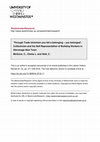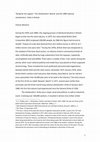Papers by Charlie McGuire
Dictionary of Irish Biography, Dec 1, 2013
... altogether retrograde step that "would put obstacles in the way of the achievement ofind... more ... altogether retrograde step that "would put obstacles in the way of the achievement ofindependence rather ... confronted him in trying to organize in the north, he consoled himself with the thought ... to melt and dissolve."30 As for Sir Edward Carson's threats of civil war, he dismissed ...
Labour History, 2008
... Issue 95 (Nov 2008). Roddy Connolly and the Struggle for Socialism in Ireland [Book Review]. ... more ... Issue 95 (Nov 2008). Roddy Connolly and the Struggle for Socialism in Ireland [Book Review]. Devlin-Glass, Frances (Reviewed by) 1. Abstract: Review(s) of: Roddy Connolly and the Struggle for Socialism in Ireland, by Charlie McGuire, Cork University Press, Cork, 2008. pp. ...

The discovery of apparent cosmological acceleration has spawned a huge number of dark energy and ... more The discovery of apparent cosmological acceleration has spawned a huge number of dark energy and modified gravity theories. The f (R) models of gravity are obtained when one replaces the Ricci scalar in the Einstein-Hilbert action by an arbitrary function f (R), S = 1 2κ d 4 x √ −g {R + f (R)} + Sm, (1) where κ ≡ 8πG is the rescaled Newton's constant, R is the Ricci scalar and Sm is the action describing the standard matter fields. In this work we provide expressions for the equations of state (EoS) for perturbations which completely characterize the linearized perturbations in f (R) gravity, including the scalar, vector, and tensor modes. The EoS formalism 1 is a powerful and elegant parametrization where the modification to General Relativity are treated as a dark-energy-fluid. The perturbed dark-energy-fluid variables such as the anisotropic stress or the entropy perturbation are explicitly given in terms of parameters of the model of interest.

History Workshop Journal, 2013
The demands of the Building Workers' Charter, launched in April 1970, were: £1 an hour basic rate... more The demands of the Building Workers' Charter, launched in April 1970, were: £1 an hour basic rate for a thirty-five hour week; three (later four) weeks of holiday plus the statutory holidays; a fully comprehensive pension scheme; total opposition to 'lump' labour; decasualization of the industry and the registration of workers; the introduction and rigid enforcement of adequate safety and health regulations; democratization of the trade unions; nationalization and public ownership of the building industry; and a single building union. 1 Such a charter was not new: it had surfaced in various forms in the history of the building industry since the repeal of the Combinations Act in 1824, and more recently in 1944 in a pamphlet, anticipating nationalization, authored by Luke Fawcett of the Amalgamated Union of Building Trade Workers (AUBTW). 2 But why did the Charter reappear in this period and why did its particular demands appeal to building workers all over Britain? The roots of the 1970 Charter lie in another rank-and-file organization, the London Joint Sites Committee (LJSC), brought to life in 1965 by building workers during a series of long and sometimes bitter disputes on the Barbican redevelopment, which eventually culminated in a year-long lock-out on Phase 4, where Myton was the contractor. These disputes not only highlighted the processes of change that had affected the structure of the industry and the building labour process since the war but also exposed the most pressing grievances of building workers and pointed to the need for a new form of organization if trade unionism in the construction industry was to survive and thrive. A wedge was dug between building-site activists and trade-union officials and the death knell sounded for the federation of craft and general unions that had proved inadequate to adapt to changes in the industry and the emergence of a multitude of new occupations.

Roddy Connolly was a leading figure in the early Irish communist movement. At the age of 15, he w... more Roddy Connolly was a leading figure in the early Irish communist movement. At the age of 15, he was involved in the Easter Rising, whose leaders included his father, James Connolly. Five years later, in 1921, he was a founding member and president of the first Communist Party of Ireland (CPI); this party was wound up by Moscow in January 1924. Two years later, Connolly helped establish another Marxist party, the Workers' Party of Ireland (WPI). Although the lifetime of this party was brief, and Connolly's involvement in it even briefer, the WPI was an important organisation. It was an attempt by Irish socialists to take advantage of the political space for a radical alternative to Cumann na nGaedheal that had lain vacant since 1923. The failure of Connolly's WPI and the success of Fianna Fail, which emerged almost simultaneously, in plugging this gap would change forever the face of Irish politics and hamper socialist prospects in the decades ahead.

The Irish revolutionary period of 1912-1923 helped stimulate and develop the political thinking a... more The Irish revolutionary period of 1912-1923 helped stimulate and develop the political thinking and outlook of the Irish left. During this period, Irish socialists and labour movement activists had to frame responses to the movement for independence, the responses of the British state, the rise of unionism, and the threat of partition. There was consensus within the Irish left on the existence of the Irish nation, the need for some degree of independence and a strident opposition to partition. In the period prior to 1916, it did appear as though Irish labour was preparing itself to challenge both unionism and nationalism for political leadership of the country as a whole. In the aftermath of the Easter Rising, however, the Irish left allowed the republican movement to monopolise leadership of the independence struggle. This resulted in the marginalisation of Irish Labour in the south and made it more difficult for activists to resist the pan-class unionist movement in the north.
Sean McLoughlin played an important role in the Easter Rising and in the revolutionary period tha... more Sean McLoughlin played an important role in the Easter Rising and in the revolutionary period that followed. He was an IRA commandant during the Civil War and a founder member of the first Communist Party of Ireland. But he made the 'mistake' of not joining Cumann na nGaedheal/Blueshirts/ Fine Gael or Fianna Fail and as such became a forgotten figure in the Ireland of 2 neo-colonies that emerged post-1922. This book was based on many years of research. Much remains to be done on McLoughlin, but this is a start, if nothing else.

Labour History Review
When it comes to self-representation of building workers, books are relatively thin on the ground... more When it comes to self-representation of building workers, books are relatively thin on the ground. Of those that have been published, perhaps one of the most colourful was Brian Behan's 1964 memoir, which included an account of a major strike on Robert MacAlpine's Shell-Mex site on the South Bank in London in 1958 that resulted in him being jailed and expelled from the Amalgamated Union of Building Trade Workers (AUBTW). 1 Another reasonably well-known memoir was published four years earlier by Donall MacAmlaigh. 2 Based on his diaries, MacAmlaigh's book was an account of his experiences on various civil engineering and building sites in the Midlands and London during the 1950s. Like Behan's autobiography, the picture painted by MacAmlaigh was of a casualised industry, where employment rights were at best precarious and often non-existent. Famous fictional accounts of construction workers lives written by workers have of course been published both by Robert Tressell and Patrick MacGill. Tressell-the pen name of Irish socialist Robert Noonan-worked for much of his relatively short life as a house painter and drew on this to produce in the Ragged Trousered Philanthropists one of the most famous novels in British literary history. Donegalborn MacGill experienced the harshness of life as a navvy working in Scotland on sites such as the Kinlochleven hydroelectric scheme in the first decade of the

Contemporary British History
The Irish Revolution of 1916-23 lies perhaps second in importance only to the Great Famine as an ... more The Irish Revolution of 1916-23 lies perhaps second in importance only to the Great Famine as an event-or related series of events-which would not so much shape as transform the course of modern Irish history thereafter. Beginning with the Easter Rising in 1916 and culminating in the Irish Civil War of 1922-23, it was a revolution that was characterised by an explosive republican challenge to British rule and astonishing levels of labour militancy, but one, ultimately, that resulted in the creation of two conservative Irish states and the thwarting of Irish republican and socialist ambitions. Not surprisingly, it is a period that has long fascinated and divided historians, but which is also currently subject to unprecedented popular interest, as the so called 'Decade of Commemoration' moves into full swing. The relationship between British social democracy and the Irish Revolution has been examined. 1 But an area that remains relatively under-researched has been the connection between British revolutionary socialists and Irish revolutionaries. Although often referred to in passing in examinations of the Irish Revolution, 2 or the British socialist movement, 3 it has rarely been the main focus of study itself. The main exceptions here are David Reed's 1984 work, Ireland: the Key to the British Revolution and Geoffrey Bell's recent Hesitant Comrades: The British Labour Movement and the Irish Revolution. Reed devoted a chapter to the 1916-1921 period. Here, a contrast was made between the 'social democratic wing'

Historical Studies in Industrial Relations
During the 1970s and 1980s, the ongoing process of deindustrialization in Britain began to bite i... more During the 1970s and 1980s, the ongoing process of deindustrialization in Britain began to bite into the steel industry. In 1975, the nationalized British Steel Corporation (BSC) employed 228,000 people; by 1986 this figure had shrunk to 54,000. 1 Output of crude steel declined from 26.5 million tonnes in 1972 to 13.7 million tonnes nine years later. 2 During the 1970s, British Steel was lampooned as the weakest of the lame-duck sectors, an industry mired in astronomical levels of debt, artificially kept afloat by huge subventions from the taxpayer, hopelessly uncompetitive and overstaffed. There were a number of key 'crisis' points during this period, when much national political and media focus was placed on these supposed shortcomings. These included the much-publicized and protracted negotiations between British Steel and the steel unions, December 1975-January 1976, when British Steel's tactless chief executive, Bob Scholey, described as 'just for starters' press speculation that 44,000 jobs were to be axed in the industry; 3 the early closure of the first of the so-called 'Beswick 'plants 4 in 1977, several years earlier than promised; and the three-month long national steelworkers strike of January-April 1980, the first the industry had experienced since the General Strike of 1926.
Irish Studies Review, 2015
Uploads
Papers by Charlie McGuire